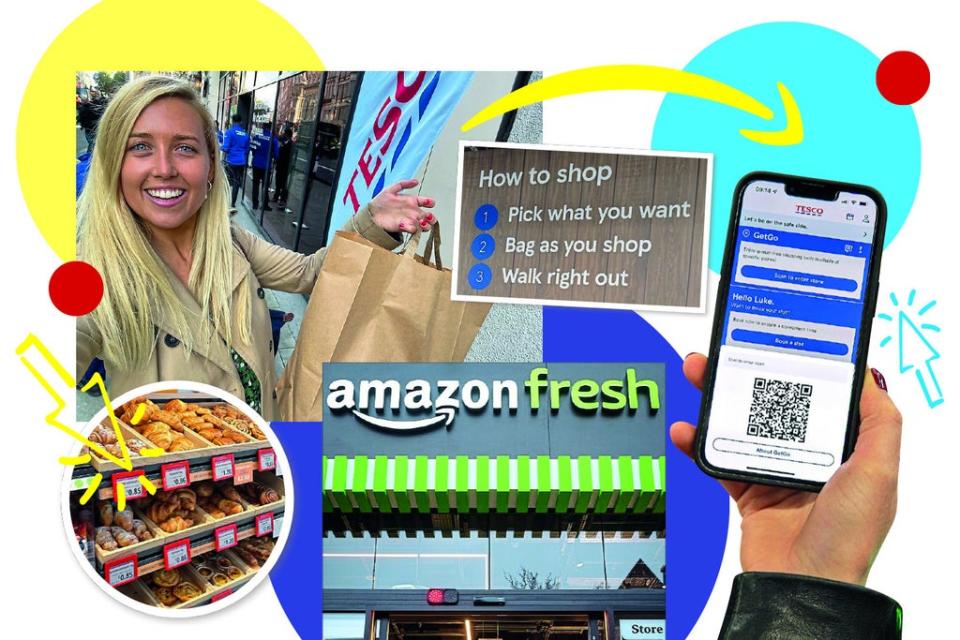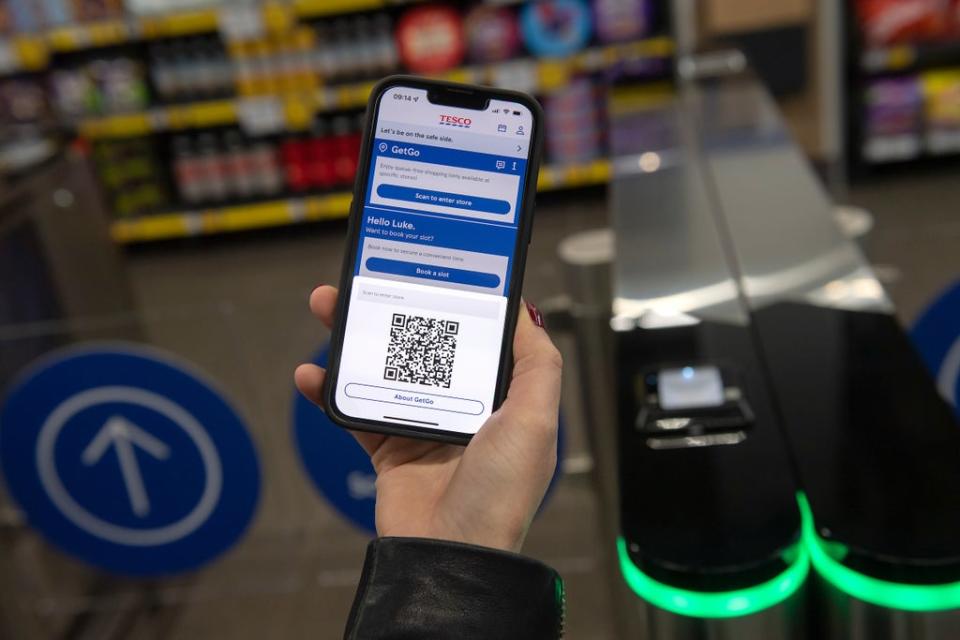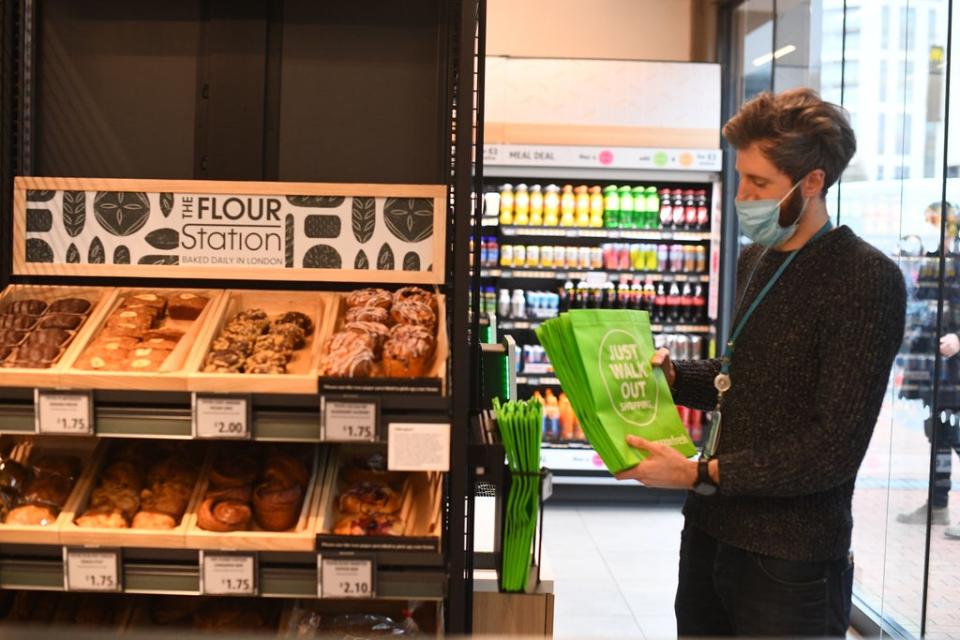A world without checkouts: How till-free supermarkets are changing London’s grocery game

Last time I walked out of a shop without paying, I had to make a red-faced trip back to Boots. This time — at a Tesco Express by Chancery Lane — I find myself being congratulated.
“How did you find it?” asks an excited staff member standing by the barriers. “Keep walking and you’ll get the receipt in a couple of minutes,” another tells me encouragingly as I clutch my brown paper bag. Seconds after walking through the exit doors, a Monzo notification tells me I’ve spent £15.52 on my supermarket haul, quickly followed by the Tesco app announcing I’ve saved £1.89. I won’t be done for shop-lifting after all.
This was my first visit to Tesco’s new checkout-free store: Tesco GetGo. The 2,000-ft supermarket on a busy office-lined street in High Holborn last week and though the aisles might look like any other Tesco store, walking in feels like a brave new world. To enter, customers tap through a Tube-style barrier using a QR code on the Tesco app before picking up their groceries as normal. No baskets? I ask an assistant, quickly realising my question is stupid. The whole point is you don’t need one: simply fill your (free) brown paper bag with items, walk out and a receipt pops up on your phone within minutes (in my case, nine seconds) of exiting the store.
The magic behind Tesco’s till-free tech lies a series of cameras and weight-sensors provided by Israeli startup Trigo, which tracks what you buy — a similar technology to that used across Amazon’s six cashier-free Amazon Go stores across the capital from Dalston to Wembley.

The first of Amazon’s “autonomous” sites opened in Ealing in March to a flurry of ‘is-this-the-future?’ headlines and now news has been leaked that Amazon plans to open 260 till-free stores nationwide in the next three years.
It’s hardly surprising: Amazon’s announcement follows a wave of UK supermarkets starting to take on Jeff Bezos’ behemoth in the last six months. Tesco says it is “looking forward to seeing how customers respond” to the GetGo trial in Holborn, chosen specifically for its busy central London location near to tech-savvy, busy office-workers. This particular Holborn store was Tesco’s first cashless outpost, so testing the supermarket’s latest technology here seemed like a “a natural progression,” explains project manager Luke Bayliss.
Rivals are already hot on Tesco’s heels. Morrisons is said to be testing a till-free concept at its Bradford head office, with plans to expand the idea more widely, and Aldi recently announced for a checkout-free store in Greenwich. Even in existing high street stores, brands are making steps towards becoming more autonomous. Sports chain Decathlon is fitted with sensor-led self-checkouts and brought in a Scan & Go payment service using customers’ phones last year. Sainsbury’s launched a similar SmartShop service two years ago, whereby customers scan items as they walk around the store.
The store feels peaceful without the checkouts - but it’s weird being watched by cameras in the ceiling
So will this so-called “frictionless” shopping experience concept take off? Almost definitely, if the hype from Tesco’s day two GetGo customers are anything to go by. “It’s amazing,” sing a chorus of curious mid-morning passers-by, mostly AirPod-wearing millennials with their phones already glued to their hands - clearly they’re not part of the 32 per cent of UK consumers surveyed by payment platform Marqeta who find till-free shopping “creepy”. So does till-less Tesco feel like a rival to online shopping? Not really, most tell me — though supermarket queues were definitely one reason they started using ultra-fast delivery apps like Weezy and Gorillas.
A passing cyclist mounts the pavement to grab a flyer (“Is it like the Amazon shop?”), while a pair of men with briefcases open their wallets and promise to come back later when they have more time to register. At least they haven’t made the mistake I did of leaving their wallets at home (unfortunately the Tesco app doesn’t use Apple Pay so I had to make a desperate call to my housemate to send me a photo of my debit card).

Once inside, the shopping experience is certainly seamless: no waiting in a queue, no “unexpected item in bagging area” alerts, no waiting for staff to come and check your ID. The store feels oddly peaceful without beeping checkouts, though there’s an eeriness to it when you realise you’re being watched by cameras in the ceiling (“The cameras view you as a stick man — or woman — as you’re walking in, so it’s all very data-privacy led,” Bayliss tries to reassure me later. Unlike CCTV cameras, these ones don’t see faces).
Walking the aisles, my thoughts turn to the staff. Six or so of them are stationed around the store to help new customers, smiling proudly in their royal blue uniforms. One woman stands guarding the booze aisle, scanning customers’ faces for their age, but the rest of her colleagues seem to be twiddling their thumbs with little to do. Are they judging my chocolate selection? Do they miss the human interaction at the tills? And more seriously, are they worried robots will eventually take their jobs altogether?

Francisca, an assistant standing outside the new GetGo site, assures me she’s not worried. In her last job, as a cashier at Tesco’s Baker Street store, she talked to customers more, but she doesn’t mind the change. “It’s more peaceful and quiet - but we still have lots to do,” she says, pointing to colleagues replenishing shelves. “Every time a customer comes in they need to sign up - they need help working out how to use the technology. In a way we need more staff. Nobody’s going to lose their job or anything. It’s new and different, but it’s not bad.”

At Superdrug next door, checkout assistant Soulaeman Adjagbe, 27, isn’t so sure. He’s been speaking to GetGo staff in his breaks and worries his own company will follow suit. He’s considering retraining in technology.
Bayliss insists jobs won’t be lost. “It’s still a service job — it’s just a different kind of service,” he adds, saying his GetGo store employs exactly the same number of staff as traditional stores — “if not more because we’ve got additional people to help sell it”.
But will the store’s friendly welcome party last after launch week? At Amazon’s Fresh’s larger 2,500-ft store in Ealing Broadway, there are just four staff on the shop floor: one on the door (on his phone), another guarding the alcohol aisle (also on his phone), one stacking shelves and another cleaning the floor by the takeaway coffee station (which might serve as a queue-free alternative to nipping into Pret).

The cleaner, Tom*, tells me he is happy working there. He used to be a waiter but earns more per hour working at the Amazon store, though he prefers standing on the door for the human interaction.
But whether the staff like it or not, it’s clear there’s a market for cashier-free convenience. “It’s just easy, isn’t it?” say Will and Anya, two 19-year-old LSE students who are back for their second visit in two days and are in and out of the store in 11 seconds with their snacks. “You just take what you want and you leave — it’s a 20-second journey,” raves Xavier Simes, 24, a warehouse worker for Waitrose who came down out of curiosity. “It’s so much easier, but it’s quite confusing because you feel like you’re stealing.”
Simes says he hopes supermarkets like his own will follow suit — it’s quick and easy and feels like the future. But quite how time-saving it is depends on who you speak to. The previous day a middle-aged customer called GetGo more of a “GetNo” experience after taking two hours and 45 minutes to get into the store (the app didn’t recognise his card details and he spent hours on the phone to the Clubcard call centre).

Still, at least he had a smartphone. Anna Cherriman, an 81-year-old grandmother who lives in Greys Inn next door, says the futuristic re-launch will stop her using her local Tesco Express altogether. “I’m not high-tech, I’m not even very good at using self-service checkouts — I don’t even know what an app is,” she tells me anxiously. From on on, she’ll have to start shopping at M&S across the road.
Putting some customers off isn’t the only cause of friction in this “frictionless” new world. Tesco’s app reportedly crashed for 24 hours this weekend - were hackers targeting the new store? Meanwhile some customers complain that the billing technology isn’t always 100% accurate. “I once got a coffee and the system didn’t recognise it,” admits Josh, 33, a software engineer who buys his lunch at Amazon’s Ealing outpost most days. Others say they’re regularly overcharged. “One thing I would say is check your bill,” warns Julie*, a 65-year-old retiree who lives nearby (she’d prefer to give her money to “a British company that pays its taxes” but is a sucker for Amazon’s sushi meal deal).
An hour later at my desk, I remember Julie’s warning and go to check my bill to discover I never received one - have I accidentally just robbed Jeff Bezos? Finally my £25 receipt comes through, two hours and 18 minutes after I left the store, by which time I’ve forgotten what I bought anyway.
Bayliss assures me there are no plans to make every Tesco store till-free. “It’s a specific type of customer who wants that quick and easy journey - others want the checkouts and like that conversation, which is absolutely fine,” he says. Presumably this is the same reason Waitrose - known for its elderly customer base and conversational checkout experience - says it won’t be following Tesco and Amazon. "We’re always looking to innovate and improve the shopping experience for our customers but we don’t have similar plans at this stage,” a spokesperson told the Standard this week.

Sainsbury’s remained coy about future plans, saying “we haven’t announced a wider roll-out of till-free stores but we’ll stay in touch”, while a spokesperson for Co-op’s convenience stores said it would be “monitoring the evolution of check-out free shopping” and continuing “to evaluate and trial new initiatives, including pay-in-aisle app technology and robot deliveries”.
So is going till-free the future, or just a gimmick to fill the gap before robot deliveries become a reality in London’s skies? According to this year’s Waitrose food and drink report, the number of people buying food in-store on a daily basis has doubled in a year - with working-from-home on the rise, that supermarket trip has become a daily ritual for many of those workers in need of an excuse to leave the house. If that’s the case, a more seamless experience can only be a good thing, Francisca tells me. “Customers walk out happier - I’m just happy to see customers happy,” she says, simply. Every little helps.
*names have been changed to protect identities
Read More
Tesco launches first checkout-free high street store
Fast food: How grocery apps like Weezy and Gorillas are changing the delivery game in London

 Yahoo Sport
Yahoo Sport 





































